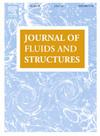Effect of incidence angle on the wake of a wall mounted slotted cylinder in an open channel flow
IF 3.4
2区 工程技术
Q1 ENGINEERING, MECHANICAL
引用次数: 0
Abstract
This experimental study investigates the wake flow generated by a vertically, wall-mounted slotted-cylinder in shallow channel flow. The slot, uniformly cut along the central plane of the cylinder, has a thickness equal to 0.1 times the cylinder diameter. The primary parameter examined is the incidence angle θ between the slot axis and the main flow direction, selected by rotating the slotted-cylinder clockwise to four different positions. The study aims to understand the impact of θ on the wake flow characteristics by investigating both the instantaneous and mean velocity fields, as well as the coherent structures. The Reynolds number, based on the water depth, is approximately 25,000. Particle image velocimetry (PIV) measurements were conducted along the vertical mid-plane and on three horizontal planes.
The results revealed the formation of three-dimensional (3D) mean recirculation zones in the wake of the cylinder without a slot, resembling a counter-rotating U-shaped vortical structure. For θ ≥ 60°, this 3D shape persists, while for θ < 60°, it varies by the angle. The jet emanating from the slot suppresses velocity fluctuations when injected into the wake region at incidence angles θ < 60° In contrast, at θ ≥ 60°, there is a transition to a stimulating effect that enhances turbulent kinetic energy (TKE) production. Proper orthogonal decomposition (POD) results highlight differences in kinetic energy transfer to the turbulent flow across various cases of the slotted-cylinder. Moreover, the slot flow exhibits both blowing and suction effects, with varying intensity and dominance throughout the shallow water layer.
明渠流动中入射角对壁挂式开槽圆柱尾迹的影响
本实验研究了浅槽流中垂直壁挂式开槽圆柱所产生的尾流。槽沿筒体中心平面均匀切割,其厚度等于筒体直径的0.1倍。研究的主要参数是槽轴与主流方向的入射角θ,通过顺时针旋转槽柱到四个不同的位置来选择。该研究旨在通过研究瞬时速度场和平均速度场以及相干结构来了解θ对尾流特性的影响。基于水深的雷诺数约为25000。粒子图像测速(PIV)测量沿垂直中平面和三个水平面进行。结果显示,在没有狭缝的圆柱体尾迹中形成三维(3D)平均再循环区,类似于反向旋转的u形涡状结构。当θ≥60°时,该三维形状保持不变,而当θ <;60°,随角度变化。当以入射角θ <注入尾流区时,从狭缝射出的射流抑制了速度波动;相反,在θ≥60°时,有一个过渡到刺激效应,增强了湍流动能(TKE)的产生。适当的正交分解(POD)结果突出了不同情况下开槽圆柱向湍流传递动能的差异。狭缝流同时具有吹吸效应,且在浅水层具有不同的强度和优势。
本文章由计算机程序翻译,如有差异,请以英文原文为准。
求助全文
约1分钟内获得全文
求助全文
来源期刊

Journal of Fluids and Structures
工程技术-工程:机械
CiteScore
6.90
自引率
8.30%
发文量
173
审稿时长
65 days
期刊介绍:
The Journal of Fluids and Structures serves as a focal point and a forum for the exchange of ideas, for the many kinds of specialists and practitioners concerned with fluid–structure interactions and the dynamics of systems related thereto, in any field. One of its aims is to foster the cross–fertilization of ideas, methods and techniques in the various disciplines involved.
The journal publishes papers that present original and significant contributions on all aspects of the mechanical interactions between fluids and solids, regardless of scale.
 求助内容:
求助内容: 应助结果提醒方式:
应助结果提醒方式:


